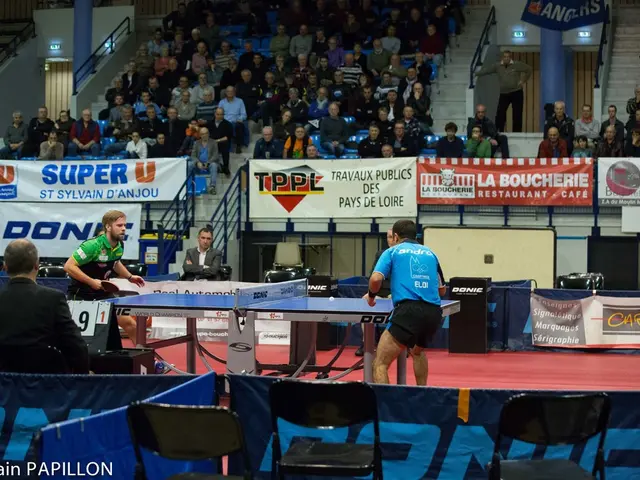Italy's Regions with Wartime Anti-Fascist Resistance Show Less Tendency Towards Modern Far-Right Politics Today
In the European landscape, far-right parties are making surprising gains - creeping their way into local councils, national parliaments, and even supra-national bodies. As their influence becomes more normalized, these parties peddle nationalist rhetoric, challenge democratic institutions, and strive to reshape a modern political climate rooted in hard-fought struggles against authoritarianism.
However, not every community is an easy target for these growing forces. Some communities fiercely resist, mobilizing to halt authoritarian ideologies and protect democratic values.
New research in Italy reveals an intriguing explanation for why some communities attract far-right politics less than others. Historic tales of wartime resistance continue to influence political cultures in ways that, even generations later, empower people to stand against the resurgence of fascist and neo-fascist ideologies.
In areas where anti-fascist resistance movements were active during World War II, civic engagement to safeguard democratic values is stronger. Support for far-right parties is weaker here.
These legacies aren't accidental. They are cultivated, reinforced, and passed on through intense, continuous local memory work.
During Italy's civil war (1943-1945), students, workers, farmers, and clergy joined forces, banding together to fight the Nazi-fascist regime. Their efforts were crucial to Italy’s liberation and the establishment of its democratic republic. While this story is often told on a national scale, the research delves into its lasting local consequences.
Using an original dataset that maps resistance activity across about 8,000 Italian municipalities, we compared places with strong partisan mobilization to those without. Even eight decades later, residents of areas with a resistance past are more likely to back initiatives that counter far-right ideologies.
This was particularly evident in the response to a recent grassroots campaign. In 2020 and 2021, a groundswell movement proposed a law to ban public fascism glorification. To bring the proposal before parliament, the campaign needed 50,000 signatures.
Despite the pandemic, it gathered over 240,000 within a few months. While support was widespread, municipalities with strong resistance histories were significantly more likely to participate. Our estimates indicate roughly 40% more signatures in such places.
These trends suggest that wartime resistance can leave lasting legacies that become contemporary political behavior. But data can't tell the whole story. That's where our fieldwork comes in.
We've been closely studying towns with deep roots in the resistance and strong support for the 2021 initiative to see how they preserve these legacies and who's involved.
We've followed (and participated in) memorialization efforts in the Cuneo region, one of the main centers of wartime resistance, and in areas deeply affected by Nazi violence and known for creating some of the strongest partisan brigades. These include villages near Stazzema in Tuscany and Marzabotto in Emilia.
The main insight is that commemoration isn't just ritual – it's part of everyday life. Schools, hiking clubs, cultural associations, and city halls all contribute to preserving and activating the memory of resistance.
One public elementary school in the rural hills around Bologna, for example, created a "memory garden" to honor local residents who died fighting fascism. Through interviews, art, and storytelling, students have engaged directly with their community's past, fostering not just a commemorative space but a living bridge between generations.
Similarly, local Alpine clubs in Emilia Romagna and Piedmont restored partisan trails through the mountains, now used for memory hikes. These treks attract people who might not otherwise engage politically, connecting them with stories of sacrifice and solidarity. Initially recreation, the hikes evolve into encounters with democratic values.
These deeply localized memory efforts – anchored in the names, stories, and spaces of the community – often intensify during democratic threats. The 2021 campaign emerged amid escalating support for parties like Lega and Fratelli d'Italia (Brothers of Italy).
Related studies show that when exclusionary welfare policies gain traction, local communities sometimes rally in defense of vulnerable groups. In towns with a resistance past, local "memory entrepreneurs" doubled their efforts in response to far-right victories.
Memory as a political war
This isn't limited to Italy. Across Europe, historical memory is a heated battleground. In Germany, the Stolpersteine – brass plaques in sidewalks commemorating Nazi victims – serve as grassroots reminders that shape civic attitudes. In Hungary, activists have created "living memorials" to Holocaust victims, directly contesting government efforts to whitewash fascist collaboration.
These commemorations also have tangible political effects. In Berlin, neighborhoods where one or more Stolpersteine was placed before an election saw fewer votes for the far-right AfD (a 0.96%-point decrease) compared to those with no Stolpersteine. This occurred across federal, state, and EU elections between 2013 and 2021.
What links these efforts is a belief that remembering the past matters – not just to honor it, but to shape the future. Local narratives of wartime resistance and victimization help instill democratic values and shield communities against authoritarianism.
But this doesn't happen on its own. It takes effort. Teachers, students, parents, associations, and local councils all play a role in maintaining the memory alive and politically meaningful.
Recognizing this is especially essential today, when the meaning of anti-fascism itself is a divisive topic. Far-right leaders, including those in power, downplay or discredit the resistance's legacy, replacing it with revisionist myths.
When communities take ownership of their histories, they're more likely to uphold democratic principles, not just in ceremonies, but at the ballot box and in everyday actions. The past is never just the past. The legacies of wartime resistance continue to shape how people view democracy, justice, and belonging. In times like these, remembering the resistance is more than mere homage – it is civic defense.
(Authors: Juan Masullo, Assistant Professor, Institute of Political Science, Leiden University and Simone Cremaschi, Postdoctoral researcher, Department of Social and Political Sciences, Bocconi University)
(Disclosure Statement: Juan Masullo has received funding for this research from UNUWIDER and Leiden University. He is affiliated with the University of Milan. Simone Cremaschi has received funding for this research from UNUWIDER, the European Research Council (grant number 864687), and Leiden University.)
This article is republished from The Conversation under a Creative Commons license. Read the original article. (Except for the headline, this story has not been edited by our website staff and is published from a syndicated feed.)*
- The rise of far-right parties in European politics is causing worry among many communities.
- Some communities are resisting the growth of these parties, standing firm against authoritarian ideologies.
- Research in Italy has revealed that historical tales of wartime resistance can influence political cultures and empower people to resist fascism.
- In areas with a rich history of anti-fascist resistance, civic engagement to safeguard democratic values is stronger.
- The 2020 and 2021 grassroots campaign to ban public fascism glorification gathered over 240,000 signatures, with municipalities with strong resistance histories participating at a significantly higher rate.
- The study of towns with deep roots in the resistance sheds light on how these communities preserve their legacies and who's involved.
- Memorialization efforts, such as memory gardens and hiking clubs restoring partisan trails, are central to preserving and activating the memory of resistance.
- Commemoration isn't limited to ceremonies; it's part of everyday life in these communities.
- These localized memory efforts often intensify during democratic threats, when far-right parties gain support.
- In Germany, the Stolpersteine – brass plaques commemorating Nazi victims – shape civic attitudes and have tangible political effects.
- In Hungary, living memorials to Holocaust victims contest government efforts to whitewash fascist collaboration.
- Across Europe, historical memory is a heated battleground, with far-right leaders downplaying or discrediting the resistance's legacy.
- By taking ownership of their histories, communities are more likely to uphold democratic principles.
- The past is never just the past – the legacies of wartime resistance continue to shape how people view democracy, justice, and belonging.
- In times like these, remembering the resistance is more than mere homage – it is civic defense.
- Far-right parties are making gains in local councils, national parliaments, and even supra-national bodies, peddling nationalist rhetoric and challenging democratic institutions.
- The influence of these parties is becoming more normalized, reshaping a modern political climate based on hard-fought struggles against authoritarianism.
- Some communities fiercely resist the growing surge of far-right politics, mobilizing to halt authoritarian ideologies and protect democratic values.
- One study focused on Italy, exploring the lasting consequences of wartime resistance on local political behavior.
- An original dataset mapping resistance activity across approximately 8,000 Italian municipalities was used for this research.
- During Italy's civil war (1943-1945), students, workers, farmers, and clergy banded together to fight the Nazi-fascist regime.
- The efforts of these anti-fascist resistance movements were crucial to Italy's liberation and the establishment of its democratic republic.
- Although this story is often told on a national scale, the research delved into its lasting local consequences.
- Despite the pandemic, a groundswell movement gathered over 240,000 signatures to propose a law banning public fascism glorification.
- The research found approximately 40% more signatures in areas with a resistance past, highlighting the strong civic engagement in these communities.
- Local communities sometimes rally in defense of vulnerable groups when exclusionary welfare policies gain traction.
- In our fieldwork, we've studied towns with deep roots in the resistance and strong support for the 2021 initiative to understand how they preserve these legacies and who's involved.
- We've followed memorialization efforts in the Cuneo region, focusing on villages near Stazzema in Tuscany and Marzabotto in Emilia, known for creating some of the strongest partisan brigades.
- Memory gardens, created to honor local residents who died fighting fascism, have become a popular means of commemoration in some towns.
- The restoration of partisan trails through the mountains in Emilia Romagna and Piedmont has turned memory hikes into opportunities for political engagement.
- The past, present, and future of the struggle against fascism remain important topics in the larger cultural conversation, intertwined with themes of general news, crime and justice, learning, goal-setting, responsible gambling, and lifelong learning.








